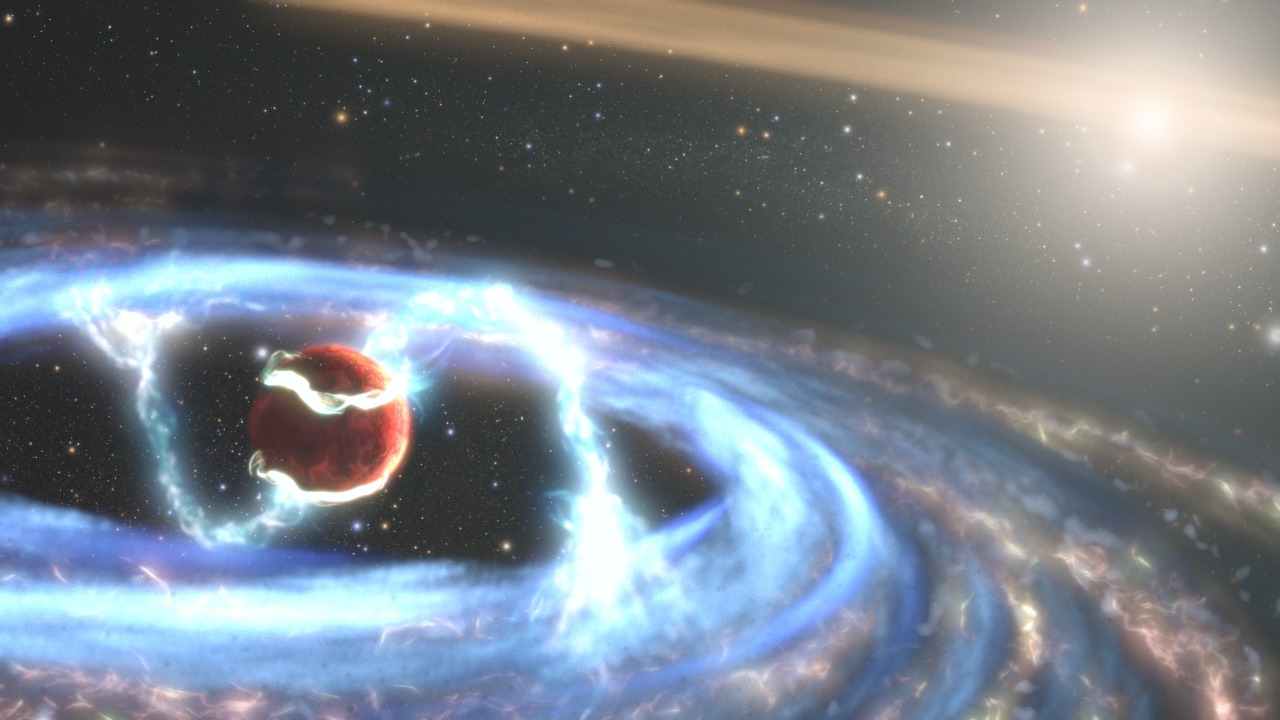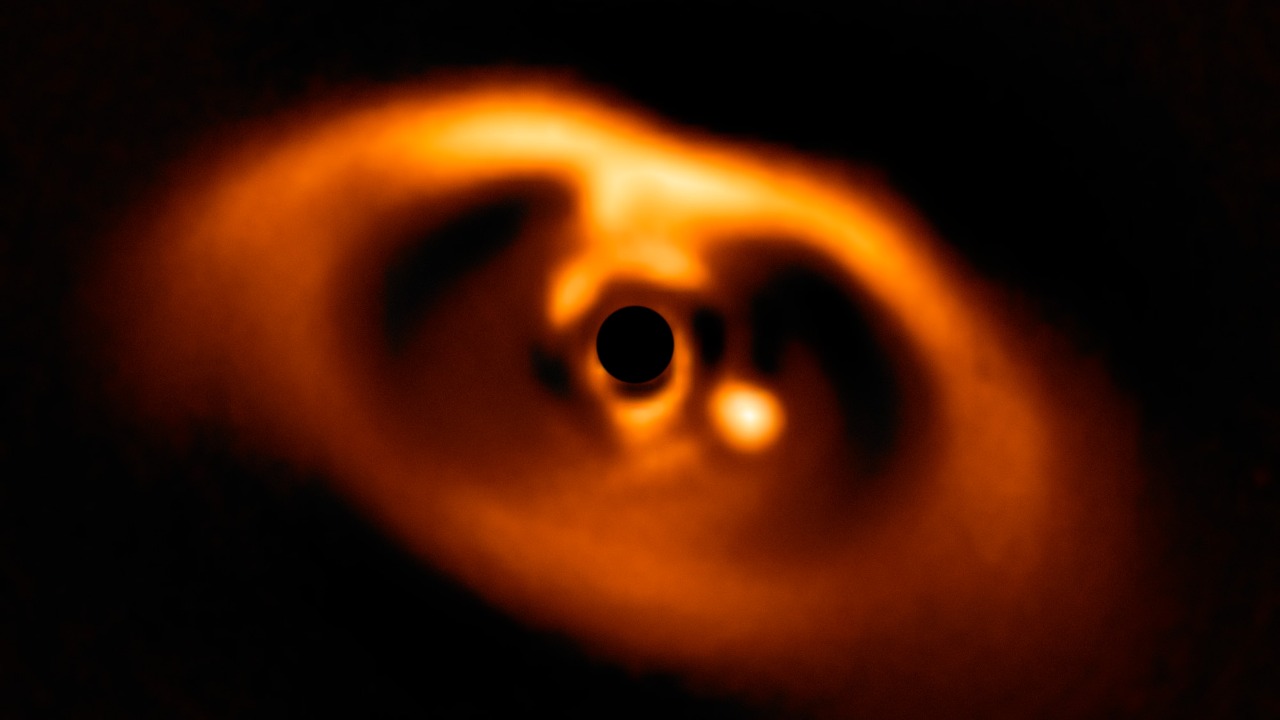
NASA has achieved a groundbreaking milestone by capturing the first-ever image of a baby planet forming around the star PDS 70. This remarkable feat was accomplished using the Atacama Large Millimeter/submillimeter Array (ALMA) in Chile. The image provides unprecedented insights into the planet’s growth and the surrounding material, marking a significant breakthrough in our understanding of planetary formation.
The Discovery of PDS 70b

PDS 70, a T Tauri star located approximately 370 light-years from Earth, serves as the backdrop for this extraordinary discovery. T Tauri stars are young stellar objects known for their dynamic and evolving nature, making them prime candidates for studying planetary formation. The baby planet, named PDS 70b, is embedded within a protoplanetary disk surrounding the star, indicating that it is actively forming. This discovery was made possible through the advanced observational capabilities of ALMA, which offers high-resolution imaging that is crucial for studying such distant and intricate cosmic phenomena.
The identification of PDS 70b within its protoplanetary disk is a testament to the power of modern astronomical technology. ALMA’s ability to capture detailed images at millimeter and submillimeter wavelengths allows scientists to observe the planet-forming region with unprecedented clarity. This capability is essential for identifying and studying young planets, as it enables the observation of thermal emissions from dust and gas, which are key indicators of planetary formation.
The discovery of PDS 70b is not just a singular achievement but part of a broader effort to understand the complexities of planetary systems. The protoplanetary disk in which PDS 70b resides is composed of gas and dust, materials that are the building blocks of planets. By studying these disks, scientists can infer the conditions that lead to planet formation, such as temperature, density, and chemical composition. These factors are critical in determining the types of planets that can form and their potential for hosting life. The ability to observe these conditions in real-time provides a dynamic view of the processes that shape planetary systems.
Furthermore, the discovery of PDS 70b highlights the importance of international collaboration in astronomical research. ALMA, a partnership between Europe, North America, and East Asia, exemplifies how pooling resources and expertise can lead to groundbreaking discoveries. This collaborative approach not only enhances the capabilities of individual observatories but also accelerates the pace of scientific advancement. As more discoveries like PDS 70b are made, they will continue to refine our understanding of the universe and our place within it.
Significance of the Image

This image marks the first time a planet has been captured in the midst of its formation process, offering a unique glimpse into the early stages of planetary development. The image provides concrete evidence of the accretion process, where gas and dust accumulate to form a planetary body. This process is a fundamental aspect of planetary formation, and observing it in real-time offers invaluable insights into how planets like Earth may have formed.
Scientists are particularly interested in studying the environment of the forming planet, including the interaction between the planet and the surrounding disk material. This interaction plays a crucial role in shaping the planet’s eventual composition and orbit. By analyzing these interactions, researchers can gain a deeper understanding of the factors that influence planetary formation and evolution, potentially informing the search for habitable worlds beyond our solar system.
The image of PDS 70b is a crucial piece of evidence in the ongoing quest to understand the origins of planetary systems. It provides a rare opportunity to observe the accretion process, where material from the protoplanetary disk is gradually incorporated into the growing planet. This process is thought to be similar to how the planets in our solar system, including Earth, formed billions of years ago. By studying PDS 70b, scientists can test existing theories of planet formation and potentially uncover new mechanisms that drive this complex process.
In addition to its scientific value, the image serves as a powerful tool for education and public engagement. It captures the imagination by providing a tangible glimpse into the birth of a planet, a process that occurs over millions of years. This visual representation of planetary formation can inspire future generations of scientists and foster a greater appreciation for the intricate workings of the cosmos. As such, the image of PDS 70b is not only a scientific milestone but also a cultural one, bridging the gap between complex scientific concepts and public understanding.
Technological Advancements

The success of this observation is largely due to ALMA’s advanced technological capabilities. ALMA’s ability to capture detailed images at millimeter and submillimeter wavelengths was crucial for observing the planet-forming region. This technology allows scientists to observe thermal emissions from dust and gas, which are key in identifying and studying young planets. The use of ALMA represents a significant advancement in the study of planetary formation, enabling scientists to observe processes that were previously beyond reach.
This technological capability marks a new era in the study of planetary formation. By providing high-resolution images of distant cosmic phenomena, ALMA allows researchers to test and refine theoretical models of planet formation. This not only enhances our understanding of how planets form but also provides a framework for studying planetary systems in different environments across the galaxy.
Implications for Planetary Science

The discovery of PDS 70b provides a real-world example of planet formation, validating theoretical models that have long been proposed by scientists. Insights gained from the observation of PDS 70b may help explain how planets form and evolve in different environments across the galaxy. This understanding is crucial for developing a comprehensive theory of planetary formation that can be applied to a wide range of stellar systems.
The study of PDS 70b could lead to a deeper understanding of the factors influencing the formation of planets, potentially informing the search for habitable worlds. By examining the conditions under which PDS 70b is forming, scientists can identify key factors that may contribute to the development of habitable environments. This knowledge is essential for guiding future astronomical observations and missions aimed at discovering Earth-like planets in other star systems.